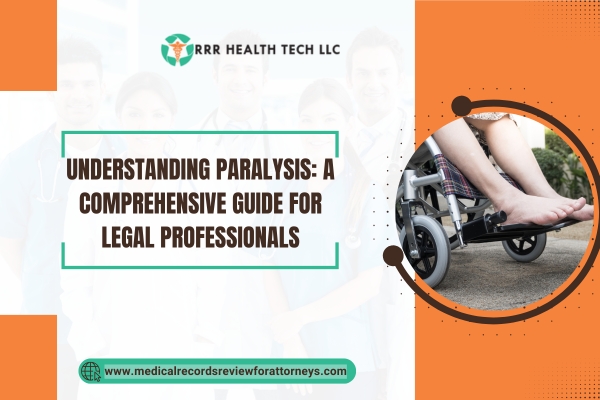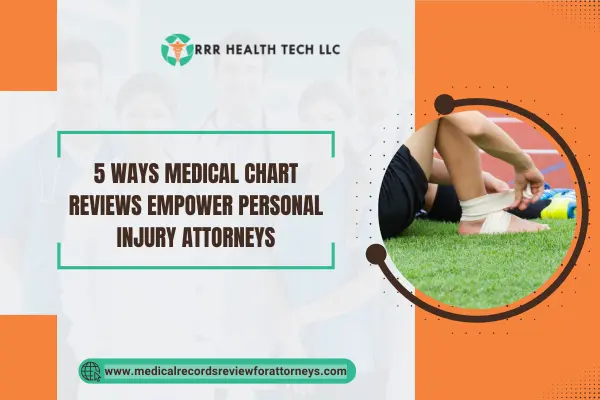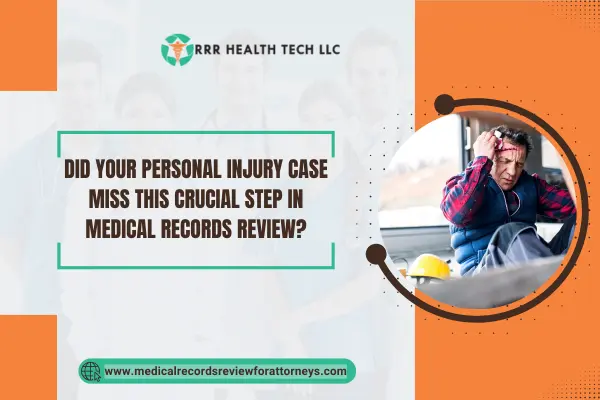
Introduction
Paralysis is described as loss of muscular movements in one or more segments of the body. It may be a great impediment to one’s quality of life and may occur due to several factors. The legal experts should also have good knowledge of the clinical features of paralysis, especially in cases of personal injuries, medical negligence, or any forms of disability. This article aims to offer a comprehensive discussion on paralysis, its variety, causes, symptoms and diagnosis, as well as the ways in which medical record review services are beneficial to attorneys in the US.
What Does Paralysis Mean?
To put it simply, paralysis is a condition that describes loss of movement on a part of the body due to nerve trauma/dysfunction. It can also be described as the inability to move a part of the body and includes, Monoplegia – affecting one limb, Hemiplegia- affecting one side of the body, Paraplegia- both legs and quadriplegia all the limbs. The construction of the demarcation of paralysis should be of great relevance to the legal practitioners since it helps in making sense of the damages of the client and the payable damages in any case.
Types of Paralysis
Monoplegia
Monoplegia is the paralysis of a single limb. It results from specific neurological disorders, localized injuries such as those sustained in trauma, and others made by medical practitioners who specialize in neurology.
Hemiplegia
A condition that occurs when one side of the body becomes paralyzed or loses control of its movement and activity, hemiplegia is frequently caused by stroke or brain dysfunction. It may create huge difficulties in movement as well as the need for thorough rehabilitation.
Paraplegia
Paraplegia is a condition where the lower half of the body is paralyzed due to an injury of the spinal column. Those who are paraplegic might understand the use of walking aids.
Quadriplegia
Due to damage to the spinal cord or indirect trauma to limbs, quadriplegia affects all four limbs and is one of the worst cases of paralysis. As this condition may lead to a total loss of body functional control, it requires the maximum amount of attention.
Triplegia
Triplegia is the paralysis of three bodily limbs, stemming from birth defects or brain injury. It creates its own limitations to mobility and performing routine tasks.
Causes of Different Kinds of Paralysis
Understanding the causes of paralysis is vital for legal professionals to evaluate liability and compensation. Common causes include:
1. Traumatic Injuries
- Spinal Cord Injuries: There is a common occurrence of paralysis due to accidents that fracture the vertebra and sections of the spinal cord.
- Brain Injuries: Traumatic brain injury (TBI) hemiplegia or even quadriplegia is common.
2. Medical Conditions
• Stroke: Caused by disruption in supplying blood to a brain, stroke in most of the cases causes hemiplegia.
• Multiple Sclerosis (MS): This typical autoimmune disorder can produce paralyzed limbs in different levels.
• Amyotrophic Lateral Sclerosis (ALS): Strengthening and voluntary control of the muscle is diminished due to progressive atrophy of motor neurons in the brain and spinal cord.
3. Infections
• Polio: Polio returns, paralyzing the limbs, but proper medical management can prevent irreversible muscular dysfunction.
• Guillain-Barre Syndrome: A very uncommon syndrome that can bring down paralysis for a short time and is life-threatening.
4. Congenital Disorders
• Paralysis from birth because of conditions like spina bifida causes mobility impairment forever and spoils quality of life requiring permanent help.
Symptoms of Paralysis
The symptoms of paralysis can vary widely based on the type and severity. Common symptoms include:
• Loss of Movement: The dicha limbs as such being inactive and inactive.
• Muscle Weakness: Power deficit pertaining to the area involved.
• Numbness or Tingling: Sensation radiating from the area of paralysis.
• Spasticity: Occasional involuntary actions of muscles.
• Loss of Coordination: The ability to perform some task is diminished.
Special Considerations
The complications caused by paralysis, such as depression or anxiety, need to be highlighted by the lawyer, since they affect the legal process.
Diagnosis of Paralysis
Diagnosing paralysis involves a comprehensive evaluation, including:
Medical History Review
• Implementation of information about the medical and injury details of the affected patient.
Neurological Examination
• Of assessing muscle strength, reflexes and coordination.
Imaging tests
• MRI and CT Scans: These imaging techniques help identify structural abnormalities in the brains or the spinal cords.
Electromyography (EMG)
• This test evaluates muscle activity through electrical impulses and helps assess the amount of damage done to the nerves themselves.
Nerve conduction studies
• These studies measure the velocity of a nerve impulse to see if it was injured and how badly it is functioning.
How Medical Records Review Services Assist Attorneys
In the process of paralysis cases, medical records review services are helpful for attorneys since the medical documents are not easy to interpret. They make it possible to:
- Identify key medical evidence: These services allow attorneys to identify key witness testimony and medical records. These include medical history, treatment, and diagnostics that are presented on the case.
- Clarify Medical Terminology: Provide explanations of complex medical terms and conditions, making it easier for attorneys to understand the implications for their clients.
- Establish Causation: Help attorneys connect the dots between the cause of paralysis and the circumstances surrounding the case, which is essential for establishing liability.
- Support Case Strategy: Offer insights into the potential long-term effects of paralysis on the client’s life, aiding in the formulation of compensation claims.
Case Studies
Case Study 1: Traumatic Brain Injury Leading to Hemiplegia
Overview of the Case
TBI was sustained in a car accident by a 35-year old gentleman who left him with hemiplegia on the right side.
Challenges
The client experienced mobility problems which necessitated extensive rehabilitation as well as modifications to his house.
Solutions
After understanding the history of the case files, it came to light that there was failure to perform fast interventions after the accident which became negligence for the other driver.
Compensation
This case ended up in a settlement that catered for medical bills, costs for rehabilitation, and pain and suffering.
Case Study 2: Spinal Cord Injury Resulting in Paraplegia
Overview of the Case
Paraplegia was caused by an accident at workplace of a 28year woman.
Challenges
Owing to her mobility challenges, the client appeared to have been living an otherwise compromised life which was in need of medical assistance as well as other related devices.
Solutions
A search of medical records concluded that there was a lack of compliance to safety measures which placed blame squarely on the employer.
Compensation
The amount paid to settle the case consisted of compensation for possible medical bills, earning losses and emotional pain.
Conclusion
It is clear that legal specialists actively participating in cases which include clients suffering from paralysis should understand the condition in detail. There are different types of paralysis, a number of different reasons for it, the preliminary diagnosis of it and its symptoms; by knowing all of this, the lawyer becomes better able to help a client. Furthermore, the use of case review services can also assist in developing case strategies and achieving better results in the case of clients in need of justice and compensation.


